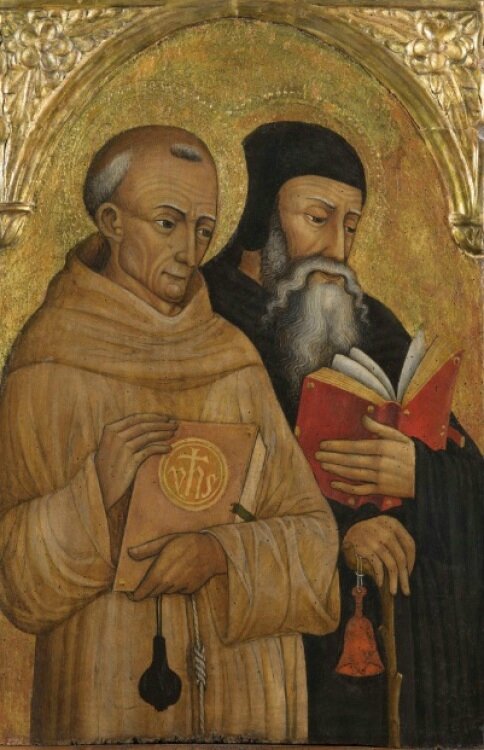Bagatti Valsecchi Museum presents the restoration of the Marinoni Polyptych
Giovanni Marinoni, Bernardino and Antonio Marinoni, the Altarpiece of St. John the Baptist, 1493. Bagatti Valsecchi Museum.
MILAN.- The Polyptych of St. John the Baptist returns home after a year being restored, and the Bagatti Valsecchi Museumcelebrates it with a compact exhibit, curated by Chiara Paratico, who has analyzed this work, as intense as it remains mysterious. Realized in 1493 by Giovanni Marinoni together with his sons Bernardino and Antonio, the polyptych is the only signed and dated piece coming from their workshop that has reached us, today. On exhibit until October 2, the polyptych is accompanied by a touch screen with videos in English and Italian that allow the visitor to contextualize the altarpiece and to know the wide-ranging activities of the Marinoni in the territory of Bergamo, better. Afterwards, the piece will return to its original position in the Bagatti Valsecchi mansion.
The Marinoni were a dynasty of painters originally from Desenzano al Serio who were active for five generations, and who dominated artistic production around Bergamo, flooding the area with polyptychs, frescoes and altarpieces. To discover this enormous body of artistic work still present in the area, a detailed map of the Val Seriana, the Val Brembana and the plains around Bergamo will be given free-of-charge to Bagatti Valsecchi Museum visitors.
If measured with fashionable contemporary painters’ experiences in Milan or Venice, the success of their painting surprises, but it can be explained by their workshop’s deeply felt attachment to their territory. The patron’s expenditure was compensated, not by creative originality, but by the quality of the materials used, the trustworthy nature of their artistic skill and the ease of understanding the depicted subject.
Following a type widely present in northern Italy at that time, the polyptych is made up of painted panels and wooden sculptures. While the paintings still exude a Late Gothic air, the sculptures, together with the large classicizing frame, look forward to the Renaissance, though their authorship is a great mystery, and leads to the hypothesis of two different artists. The nervous and deeply cut lines of the St. John the Baptist seem to point to the area around Venice, while the Female Saint in the upper register shows more affinity with Pietro Bussolo, a Milanese sculptor present in the areas around Bergamo from the 15th to the 16th centuries, and with whom the Marinoni collaborated on more than one occasion.
Giovanni Marinoni, Bernardino and Antonio Marinoni, the Altarpiece of St. John the Baptist (detail), 1493. Bagatti Valsecchi Museum.
‘The Marinoni workshop surprises for its capacity to enter into dialogue with the great masters passing through the area around Bergamo, such as Pietro Bussolo, and above all for the close rapport with the “discoveries” of Vincenzo Foppa, archetype of the great Renaissance revolution of the area in the Paduan plains,’ asserts Chiara Paratico, exhibit curator. ‘Compared with more illustrious models (Foppa, Bramante and Mantegna), there is no pretension to originality, rather, there is an emulation of the same iconographical solutions, often without really understanding them. In the slow renewal of traditional types, the Marinoni represent an eloquent witness of an approach to painting as a “trade,” and to the piece of art as precious “material”: a choral work produced by artisans, masters of “the art of doing,” quite different from the modern concept of “making art”.’
‘This initiative dedicated to the Polyptych of St. John the Baptist is not only a way to highlight a work in the Bagatti Valsecchi Collection,’ affirms Lucia Pini, Museum Conservator, ‘but also is a way to underscore how works of art can form deep ties with their territories. Figurative culture isn’t made up only of “movers and shakers,” but is a much richer and finely woven textile. Fausto and Giuseppe understood this, as shown by their acquisition of this work whose poly-material aspect they most certainly appreciated.’
The lack of provenance information doesn’t help us to resolve any remaining doubts, though it is certain that the brothers reserved a scenographic place for it in their family mansion – now a museum – on the landing of the monumental Santo Spirito stairway, where they had it imbedded in the wall. In line with the attention the brothers gave to this polyptych, the Foundation has decided to offer to Milan and to its visitors the opportunity to reflect on the art spread throughout the valleys around Bergamo during the Renaissance.
In addition to the support for the exhibit offered by the Region of Lombardy, the technical support of the Studio Lissoni Associati for the project proposal has made this exhibit possible.
During the summer months of July and September, the museum and the exhibit will stay open with special hours on Thursdays until 8:30 P.M. At 7 P.M., it will be possible to participate in a guided visit in Italian, free-of-charge upon paying the museum entrance fee (reservations required).
Giovanni Marinoni, Bernardino and Antonio Marinoni, the Altarpiece of St. John the Baptist, 1493. Bagatti Valsecchi Museum.

/https%3A%2F%2Fprofilepics.canalblog.com%2Fprofilepics%2F1%2F0%2F100183.jpg)
/https%3A%2F%2Fstorage.canalblog.com%2F03%2F02%2F119589%2F96711876_o.jpg)
/https%3A%2F%2Fstorage.canalblog.com%2F11%2F31%2F119589%2F94773502_o.jpg)
/https%3A%2F%2Fstorage.canalblog.com%2F20%2F83%2F119589%2F94772815_o.jpg)
/https%3A%2F%2Fstorage.canalblog.com%2F26%2F72%2F119589%2F75604929_o.jpg)
/https%3A%2F%2Fstorage.canalblog.com%2F59%2F60%2F119589%2F26458628_o.jpg)







/http%3A%2F%2Fstorage.canalblog.com%2F95%2F54%2F119589%2F129224414_o.jpg)
/http%3A%2F%2Fstorage.canalblog.com%2F09%2F79%2F119589%2F111031700_o.jpg)
/image%2F1371349%2F20240417%2Fob_9708e8_telechargement.jpg)
/image%2F1371349%2F20240417%2Fob_91ce89_x5173-online-caravaggio-the-martyrdom.jpg)